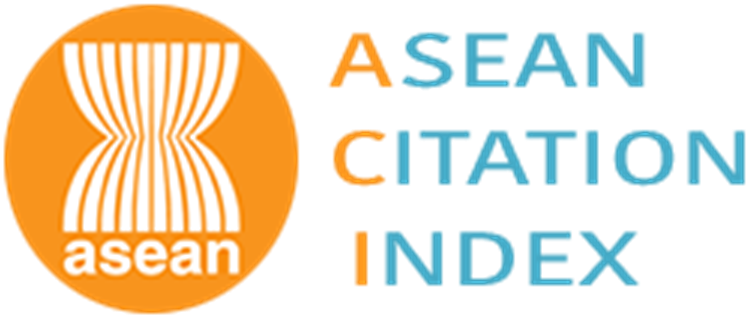การประเมินความเสี่ยงการสลายตัวทางความร้อนของแคลเซียมไฮโปคลอไรท์โดยดิฟเฟอเรนเชียลสแกนนิงแคลอริมิเตอร์
Risk Assessment of Thermal Decomposition of Calcium Hypochlorite by Differential Scanning Calorimetry
Abstract
แคลเซียมไฮโปคลอไรท์เป็นสารออกซิไดซ์ที่รุนแรง เมื่อได้รับความร้อนสามารถเกิดเพลิงไหม้และระเบิดได้ ในงานวิจัยนี้ได้ทำการประเมินการสลายตัวทางความร้อนของแคลเซียมไฮโปคลอไรท์ เกรดการค้า ความเข้มข้นร้อยละ 65 โดยน้ำหนัก โดยดิฟเฟอเรนเชียลสแกนนิงแคลอริมิเตอร์ เปลี่ยนแปลงอัตราการให้ความร้อน 4, 6 และ 8 เคลวินต่อนาที ผลการทดลองพบว่า อุณหภูมิเริ่มต้นการสลายตัวและจุดเดือดของแคลเซียมไฮโปคลอไรท์ มีอุณหภูมิใกล้เคียงกันมาก การสลายตัวเป็นปฏิกิริยาคายความร้อนมีค่าสูงสุดเท่ากับ 355.4 จูลต่อกรัม พลังงานกระตุ้นมีค่าเท่ากับ 88.7 กิโลจูลต่อโมล อันตรายทางความร้อนประเมินจาก อุณหภูมิการสลายตัวภายใต้สภาวะแอเดียแบติกที่เพิ่มสูงขึ้น และเวลาที่อัตราเร็วของปฏิกิริยาภายใต้สภาวะแอเดียแบติกเพิ่มสูงขึ้นมากที่สุด พบว่ามีค่าเท่ากับ 220.0 เคลวิน และ 27.2 วินาที ตามลำดับ ความว่องไวต่อปฏิกิริยาเคมี พบว่าแคลเซียมไฮโปคลอไรท์เป็นสารเคมีที่มีความเสถียรทางความร้อนปานกลาง และอาจเกิดปฏิกิริยาเคมีที่รุนแรงเมื่อสัมผัสกับสารอินทรีย์
Calcium hypochlorite is a strong oxidizer that can cause fire and explosion when heated. This study examined thermal decomposition of commercial grade containing 65% calcium hypochlorite by using differential scanning calorimetry technique at heating rates 4, 6 and 8 K/min. It was found that the onset temperature and the boiling temperature of the calcium hypochlorite were almost the same. The maximum exothermic enthalpy decomposition value was 355.4 J/g and the activation energy was 88.7 kJ/mol. The thermal hazard was evaluated by using the adiabatic decomposition temperature and the time to maximum rate appeared to be 220.0 K and 27.2 second, respectively. It was found that the instability rate of the calcium hypochlorite was stable at the medium level. The violent chemical reaction can occur when the calcium hypochlorite contact with organic substances.
Keywords
[1] Cargo Incident Notification System and International Group of P&I Clubs. (2018, January). Guidelines for the carriage of calcium hypochlorite in containers. Version 3.0. United Kingdom. [Online]. Available: https://www.iims. org.uk/wp-content/uploads/2018/01/120118- calcium-hypochlorite-guidelines-cins-igpi-2018- final-version.pdf
[2] D. M. Bibby and N. B. Milestone, “The decomposition of high grade bleaching power (Calcium hypochlorite),” Journal of Chemical Technology & Biotechnology, vol. 34, no. 8, pp. 423–430, 1984.
[3] K.B. De Paula, I. B. Carlotto, D. F. Marconi, M. B. C. Ferreira, F. S. Grecca, and F. Montagner, “Calcium hypochlorite solutions – An in vitro evaluation of antimicrobial action and pulp dissolution,” European Endodontic Journal, vol. 4, no. 1, pp. 15–20, 2019.
[4] P. Chanettee, “Treatment of molar endodontic with periapical lesion: A case report,” Region 6-7 Medical Journal, vol. 27, no. 2–2, pp. 795–800, 2008 (in Thai).
[5] C. Limsuwan, N. Chuchird, and K. Laisutisan, “Efficacy of calcium hypochlorite on the prevalence of microsporidiosis (Thelohania) in pond-reared Litopenaeus vannamei,” Kasetsart Journal (Natural Science), vol. 42, no. 2, pp. 282–288, 2008 (in Thai).
[6] Y. S. Su, D. T. Morrison III, and R. A. Ogle, “Chemical kinetics of calcium hypochlorite decomposition in aqueous solution,” Journal of Chemical Health & Safety, vol. 16, no. 3, pp. 21–25, 2009.
[7] C. Winder and A. Zarei, “Incompatibilities of chemicals,” Journal of Hazardous Materials, vol. 79, no. 1–2, pp. 19–30, 2000.
[8] Y. Uehara, H. Uematsu, and Y. Saito, “Thermal ignition of calcium hypochlorite,” Combustion and Fire, vol. 32, pp. 85–94, 1978.
[9] B. F. Gray and B. Halliburton, “The thermal decomposition of hydrated calcium hypochlorite UN 2880,” Fire Safety Journal, vol. 35, pp. 223–239, 2000.
[10] M. Wagner, Thermal Analysis in Practice: Fundamental Aspects. Munich: Hanser Publishers, 2018.
[11] Z. X. Xua, Q. Wanga, and X.-Qi Fu, “Thermal stability and mechanism of decomposition of emulsion explosives in the presence of pyrite,” Journal of Hazardous Materials, vol. 300, pp. 702–710, 2015.
[12] C. Zheng, D. Li, and M. Ek, “Mechanism and kinetics of thermal degradation of insulation materials developed from cellulose fiber and fire retardants,” Journal of Thermal Analysis and Calorimetry, vol. 135, pp. 3015–3027, 2019.
[13] J. Lv, W. Chen, L. Chen, Y. Tian, and J. Yan, “Thermal risk evaluation on decomposition processes for four organic peroxides,” Thermochimica Acta, vol. 589, no. 10, pp. 11–18, 2014.
[14] V. J. Clancey, “Fire hazardous of calcium hypochlorite,” Journal of Hazardous Materials, vol. 1, no. 1, pp. 83–94, 1975.
[15] Standard practice for calculation of hazar dous potential figures of merit for thermally unstable materials, ASTM E1231, 2015.
[16] F. Stoessel, Thermal Safety of Chemical Processes: Risk Assessment and Process Design, Basel: Wiley-VCH, 2008.
[17] L. Bou-Diab and H. Fierz, “Autocatalytic decomposition reactions, hazards and detection,” Journal of Hazardous Materials, vol. 93, no. 1, pp. 137–146, 2002.
[18] S. Anothairungrat and K. Piyamongkala, “Risk assessment of thermal hazard and reactivity of hydrogen peroxide by differential scanning calorimetry,” The Journal of KMUTNB, vol. 29, no. 2, pp. 292–301, 2019 (in Thai).
[19] S. Y. Wang, A. A. Kossoy, Y. D. Yao, L. P. Chen, and W. H. Chen, “Kinetics-based simulation approach to evaluate thermal hazard of benzaldehyde oxime by DSC teats,” Thermochimica Acta, vol. 655, pp. 319–325, 2017.
[20] L. Zhang, W. D. Yu, X. H. Pan, J. J. Fang, M. Hua, F. M. Chen, and J. C. Jiang, “Thermal hazard assessment for synthesis of 3-methylpyridine- N-oxide,” Journal of Loss Prevention in the Process Industries, vol. 35, pp. 316–320, 2015.
[21] M. Das and C. M. Shu, “A green approach towards adoption of chemical reaction model on 2,5-dimethyl-2,5-di-(tert-butylperoxy) hexane decomposition by differential isoconversional kinetic analysis,” Journal of Hazardous Materials, vol. 301, no. 1, pp. 222–232, 2016.
[22] M. Eissen, A. Zogg, and K. Hungerbuhler, “The runaway scenario in the assessment of thermal safety: Simple experimental access by means of the catalytic decomposition of H2O2,” Journal of Loss Prevention in the Process Industries, vol. 16, no.4, pp. 289–296, 2003.
[23] T. Gołofit, “Thermal behaviour and safety of 1,3,7,9-tetranitrodibenzo-1,3a,4,6a tetraazapentalen (z-TACOT),” Thermochimica Acta, vol. 667, pp. 59-64, 2018.
[24] Standard test method for Arrhenius kinetic constants for thermally unstable materials. using differential scanning calorimetry and the Flynn/Wall/Ozawa method, ASTM E698, 2011.
[25] T. C. Hofelich, B. A. Prine, and N. E. Scheffier, “A quantitative approach to determination of NFPA reactivity hazard rating parameters,” Process Safety Progress, vol. 16, no. 3, pp. 121–125, 1997.
[26] M. Surianarayanan, R. Vijayaraghavan, G. Swaminathan, and P. G. Rao, “Microcalorimetry and its role in thermal hazard quantification,” Current Science, vol. 80, no. 6, pp. 738–747, 2001.
[27] Santa Cruz Biotechnology. (2018, April). Calcium hypochlorite safety data sheet. Version 1.1. Santa Cruz Biotechnology, Dallas, TX. [Online]. Available: https://datasheets.scbt.com/sds/ aghs/en/sc-214653.pdf
DOI: 10.14416/j.kmutnb.2021.09.006
ISSN: 2985-2145





